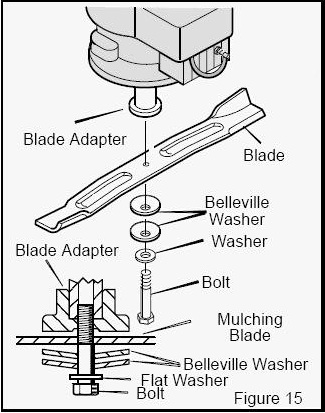How is the blade from my walk behind lawnmower removed?
Blade Service
WARNING: Before you inspect the blade or the blade adapter, disconnect the wire to the spark plug. If the blade hits an object, stop the engine. Disconnect the wire to the spark plug. Check the unit for damage.
Frequently check the blade for wear or damage such as cracks. Frequently check the bolt that holds the blade. Keep the bolt tight. If the blade hits an object, stop the engine, disconnect the wire from the spark plug, and check the blade adapter for damage. Check for a bent/damaged blade, a badly worn blade, or other damage.
Before you operate the unit, damage parts must be replaced with factory replacement parts. For safety, replace the blade every two years. Keep a sharp edge on the blade. A blade that is not sharp will cause the ends of the grass to become brown.
BLADE REMOVAL WARNING: Before you remove the blade, disconnect the wire to the spark plug. The blade has sharp edges. When you hold the blade, use gloves or cloth material to protect your hands.
The following is the blade removal procedure for a typical walk behind lawnmower:
Drain the fuel tank.
Lift the side of the mower that has the muffler or spark plug.
Use a piece of wood to deep the blade from rotating.
Remove the bolt that holds the blade. Briggs & Stratton engines that are used on walk behind lawnmowers use a right hand thread and would be loosened by turning counter-clockwise.
Check the blade according to the "Blade Service" instructions listed above. Replace a badly worn or damaged blade.
Mount the blade with the curved edges toward the housing. If the blade is upside down, the blade will not cut correctly and can cause an accident.
Fasten the blade with original washers and bolt. Make sure the outside rims of the Belleville washers are toward the blade.
Tighten the bolt that holds the blade to a torque of 30 ft. lbs.
WARNING: Always keep the bolt that holds the blade tight. A loose bolt or blade can cause an accident.

Please read and abide by any applicable Safety Information contained in your product Operator's Manual. The material provided above is not intended to replace work performed by a Murray Authorized Dealer. Terms of Use apply to all of the information presented on this website. Always be sure to completely read and understand your product Operator's Manual.



